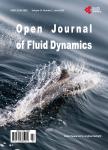Fore-Body Side Vortex of KVLCC2 at 30°Drift: A Trailing Vortex Resolved with DES and Compared to PIV Data
Fore-Body Side Vortex of KVLCC2 at 30°Drift: A Trailing Vortex Resolved with DES and Compared to PIV Data作者机构:FDS/TUHH Hamburg Germany
出 版 物:《Open Journal of Fluid Dynamics》 (流体动力学(英文))
年 卷 期:2019年第9卷第4期
页 面:303-325页
学科分类:080704[工学-流体机械及工程] 080103[工学-流体力学] 08[工学] 0807[工学-动力工程及工程热物理] 0801[工学-力学(可授工学、理学学位)]
主 题:KVLCC2 DES Hybrid RANS-LES PIV Trailing Vortex Drift
摘 要:A hybrid RANS-LES approach is used to resolve the Fore-body Side Vortex (FSV) separating from the KVLCC2 hull at 30° drift angle and Reynolds number ReLoa ≈ 2.56e6. The performance of the DES approach is evaluated using a proper grid study. Besides, the following aspects of the CFD results are investigated: the resolution of turbulent energy, the prediction of instantaneous and time-averaged vortical structures, local flow features, the limiting streamlines and the evolution of the vortex core flow. New PIV data from wind tunnel experiments is compared to the latter. The results form a basis for future investigations in particular on the vortex interaction further downstream and the applicability of different kinds of turbulence models to trailing vortices like the FSV. Turbulence modelling is realised with the k-ω-SST-IDDES model presented in [1], the grids’ cell count is 6.4 M, 10.5 M and 17.5 M. Grid convergence of the time-averaged vortex core flow is observed. OpenFOAM version 1806 is used to carry out the simulations and snappyHexMesh to build the mesh.



